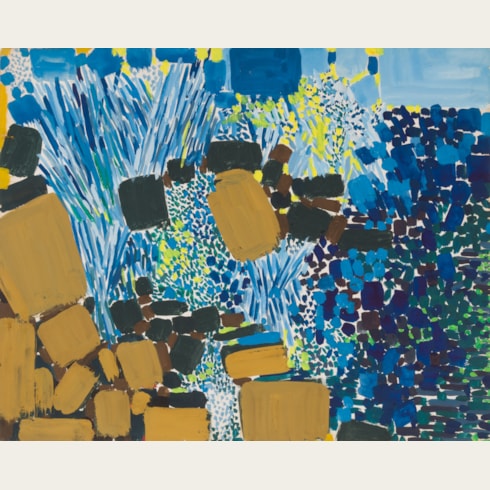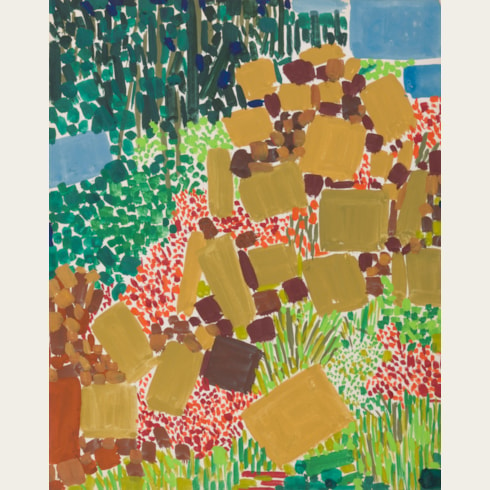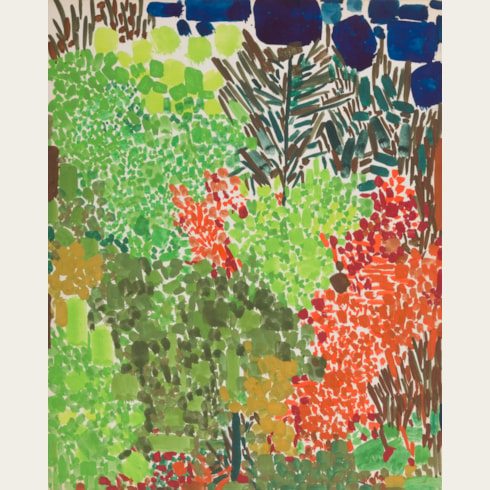Lynne DREXLER
(Newport News 1928 - Monhegan Island 1999)
Untitled, c.1959
Watercolour.
Inscribed LD - PW. 188 in pencil on the verso.
165 x 290 mm. (6 1/2 x 11 3/8 in.)
Inscribed LD - PW. 188 in pencil on the verso.
165 x 290 mm. (6 1/2 x 11 3/8 in.)
Lynne Drexler’s work was always first and foremost about colour. The artist’s characteristic use of squarish patches of vibrant colour, applied with short brushstrokes, is seen to brilliant effect in this early watercolour, which is datable to c.1959. The present sheet also reflects something of the influence on Drexler of her training with Hans Hofmann, notably his particular emphasis on a rhythmic approach to composition and a vibrant colour palette. This devotion to colour was something that Drexler also admired in the work of such artists as Vincent van Gogh and Henri Matisse, with whom her works were often likened by later writers.
A number of stylistically comparable drawings in watercolour or gouache of the same date remain in the artist’s estate, while others are in private collections.
A number of stylistically comparable drawings in watercolour or gouache of the same date remain in the artist’s estate, while others are in private collections.
Born in south-eastern Virginia, Lynne Mapp Drexler studied at the Richmond School of Art, graduating with a degree in Fine Art in 1949. After two trips to Europe in the early 1950s, during which she spent a considerable amount of time in London, she began to study painting seriously. In late 1955 she decided to move to New York City to study with the German-born painter and renowned art teacher Hans Hofmann, enrolling in his school in February 1956 and also earning a scholarship to his summer class in Provincetown, Massachusetts, in 1957. (Among his students, Hofmann counted several of the most significant women artists of the period, including Nell Blaine, Ray Eames, Marisol Escobar, Helen Frankenthaler, Jane Freilicher, Lee Krasner and Mercedes Matter.) Hofmann taught Drexler to focus on painting in terms of colour, form and space, and his theories about musical analogies in chromatic scales resonated with the younger artist.
When Hofmann closed his New York school, and at his recommendation, Drexler began studying with the Abstract Expressionist painter Robert Motherwell at Hunter College. Both Hofmann and Motherwell strongly supported and encouraged the artist in her work, whose qualities they readily recognized. (However, when she told Motherwell that she was thinking of becoming a teacher herself, he is said to have replied, ‘I’ll flunk you out of here before I see you go to teach. You’re too good a painter.’) As a disciple of both Hofmann and Motherwell, Drexler became associated with the second generation of Abstract Expressionist painters. By the late 1950s she had come of age as an artist, and her first solo exhibition of eleven brightly-coloured abstract paintings was held at the artist’s cooperative Tanager Gallery in New York in 1961, although none of the works sold.
The following year Drexler married the abstract painter John Hultberg, whose career was much more established than hers, since he had gained the support of the gallerist Martha Jackson. In 1961, with Jackson’s help, Hultberg had bought a summer house on Monhegan Island, several miles off the coast of Maine, and he and Drexler spent the summer of 1963 there. They returned to Monhegan almost every year thereafter, and much of Drexler’s later work was inspired by the landscape of this small and remote island. The couple spent some of the next few years on the move, usually due to Hultberg’s teaching commitments. They briefly lived in San Miguel de Allende in Mexico before moving to San Francisco, where they spent a year and half. It was in California that Drexler produced her first lithographs, at the Tamarind Lithography Workshop in Los Angeles in 1963.
In 1965 Drexler had her second solo exhibition at a gallery in Los Angeles, which was well reviewed by local critics. (The art critic of the Los Angeles Times noted of her that ‘the artist impresses by her technical virtuosity and her distinctively personal, highly exuberant poetry. Essentially a colorist to whom texture is nearly as important as tonality, this painter manages to sum up characteristic facets of landscape experience ranging from an almost blinding stridency to calculatedly lyrical subtleties.’) After some time in Hawaii, where Drexler had another exhibition of her work, she and Hultberg settled in New York City in 1967, living at the Chelsea Hotel, where her paintings were hung in the lobby alongside those of other artists who resided there, notably Larry Rivers. Apart from an obvious debt to nature, Drexler’s works were also sometimes inspired by her abiding love of classical music, and she would often sketch while listening to concerts and performances at Carnegie Hall or the Metropolitan Opera.
Drexler spent the summer months on Monhegan Island sketching outdoors, creating a repertory of images that would provide the basis for larger abstract paintings created in the winter months in New York. By this time, however, Hultberg’s alcoholism was proving very difficult for her to cope with, so much so that summers with him on Monhegan were sometimes miserable experiences for Drexler, and she sometimes avoided spending time there with him. In 1970 she was hospitalized for severe depression; as she wrote in a letter to Hultberg at around this time, ‘my belief in my own creativity keeps me going but who will know or care 100 years from now?’ By 1975 Hultberg and Drexler had moved into an apartment in Soho, and Drexler had shown her colourful paintings in a series of four critically-praised exhibitions at the Alonzo Gallery on the Upper East Side. This period, between 1969 and 1975, marks the highpoint of Drexler’s commercial and critical success during her lifetime. However, she was never able to gain gallery representation and support, and struggled to achieve wider recognition. Nevertheless, she once noted that, ‘I’ve always felt deeply within myself I was a damn good artist, though the world didn’t recognize me as such. I wasn’t about to play their game.’
In 1983 Drexler abandoned New York to settle permanently on Monhegan Island, where she lived and worked alone for the last sixteen years of her life. (She and Hultberg eventually separated in 1984, though they never divorced.) The artist was happy there and began to sell her work to a handful of Maine collectors. The scenery of Monhegan was a continuing inspiration, and she became a firm part of the tiny, closely-knit community of people who lived on the small, rocky island year-round. As she pointed out, ‘There is no isolation in a place like this – impossible to find – but solitude is respected…I am not rich…but I have what I want. I mean, as long as I have food, heat, roof over my head, food for the cat and paint, I am happy. Oh, and Jack Daniels.’ By the early 1990s Drexler’s work had become more stylized and representational, though still brilliantly coloured and, as always, anchored in a love of nature. She continued to work productively, content in the solitude of her beloved Monhegan Island, until her death, while listening to Mozart’s opera Don Giovanni, in December 1999, at the age of seventy-one.
Following Drexler’s death, in relative obscurity, stacks of unframed paintings and watercolour and gouache drawings, dating from the 1950s to the 1990s, were discovered in her home. Gradually her work began to attract a new audience, initially in Maine and then well beyond the state. In 2008 the first museum retrospective of Drexler’s oeuvre, numbering some fifty paintings, drawings and textiles, was presented at the Monhegan Museum and the Portland Museum of Art in Maine. More recently an exhibition devoted to the artist’s abstract works of the late 1950s and 1960s was held jointly at the Mnuchin and Berry Campbell galleries in New York, while another exhibition of her work was mounted at Bonhams auction house in New York. In 2023 representation of the Drexler estate was assumed by the White Cube gallery, which mounted the first European exhibition of her work in London in the winter of 2024-2025, to be followed by an exhibition in Hong Kong in March 2025. Paintings, drawings and prints by Lynne Drexler are today in the permanent collections of, among others, the Brooklyn Museum, the Art Institute of Chicago, the Hammer Museum in Los Angeles, the Museum of Modern Art in New York and the National Gallery of Art in Washington, D.C., as well as the Bates College Museum of Art, the Farnsworth Art Museum, the Monhegan Museum and the Portland Museum of Art, all in Maine.
When Hofmann closed his New York school, and at his recommendation, Drexler began studying with the Abstract Expressionist painter Robert Motherwell at Hunter College. Both Hofmann and Motherwell strongly supported and encouraged the artist in her work, whose qualities they readily recognized. (However, when she told Motherwell that she was thinking of becoming a teacher herself, he is said to have replied, ‘I’ll flunk you out of here before I see you go to teach. You’re too good a painter.’) As a disciple of both Hofmann and Motherwell, Drexler became associated with the second generation of Abstract Expressionist painters. By the late 1950s she had come of age as an artist, and her first solo exhibition of eleven brightly-coloured abstract paintings was held at the artist’s cooperative Tanager Gallery in New York in 1961, although none of the works sold.
The following year Drexler married the abstract painter John Hultberg, whose career was much more established than hers, since he had gained the support of the gallerist Martha Jackson. In 1961, with Jackson’s help, Hultberg had bought a summer house on Monhegan Island, several miles off the coast of Maine, and he and Drexler spent the summer of 1963 there. They returned to Monhegan almost every year thereafter, and much of Drexler’s later work was inspired by the landscape of this small and remote island. The couple spent some of the next few years on the move, usually due to Hultberg’s teaching commitments. They briefly lived in San Miguel de Allende in Mexico before moving to San Francisco, where they spent a year and half. It was in California that Drexler produced her first lithographs, at the Tamarind Lithography Workshop in Los Angeles in 1963.
In 1965 Drexler had her second solo exhibition at a gallery in Los Angeles, which was well reviewed by local critics. (The art critic of the Los Angeles Times noted of her that ‘the artist impresses by her technical virtuosity and her distinctively personal, highly exuberant poetry. Essentially a colorist to whom texture is nearly as important as tonality, this painter manages to sum up characteristic facets of landscape experience ranging from an almost blinding stridency to calculatedly lyrical subtleties.’) After some time in Hawaii, where Drexler had another exhibition of her work, she and Hultberg settled in New York City in 1967, living at the Chelsea Hotel, where her paintings were hung in the lobby alongside those of other artists who resided there, notably Larry Rivers. Apart from an obvious debt to nature, Drexler’s works were also sometimes inspired by her abiding love of classical music, and she would often sketch while listening to concerts and performances at Carnegie Hall or the Metropolitan Opera.
Drexler spent the summer months on Monhegan Island sketching outdoors, creating a repertory of images that would provide the basis for larger abstract paintings created in the winter months in New York. By this time, however, Hultberg’s alcoholism was proving very difficult for her to cope with, so much so that summers with him on Monhegan were sometimes miserable experiences for Drexler, and she sometimes avoided spending time there with him. In 1970 she was hospitalized for severe depression; as she wrote in a letter to Hultberg at around this time, ‘my belief in my own creativity keeps me going but who will know or care 100 years from now?’ By 1975 Hultberg and Drexler had moved into an apartment in Soho, and Drexler had shown her colourful paintings in a series of four critically-praised exhibitions at the Alonzo Gallery on the Upper East Side. This period, between 1969 and 1975, marks the highpoint of Drexler’s commercial and critical success during her lifetime. However, she was never able to gain gallery representation and support, and struggled to achieve wider recognition. Nevertheless, she once noted that, ‘I’ve always felt deeply within myself I was a damn good artist, though the world didn’t recognize me as such. I wasn’t about to play their game.’
In 1983 Drexler abandoned New York to settle permanently on Monhegan Island, where she lived and worked alone for the last sixteen years of her life. (She and Hultberg eventually separated in 1984, though they never divorced.) The artist was happy there and began to sell her work to a handful of Maine collectors. The scenery of Monhegan was a continuing inspiration, and she became a firm part of the tiny, closely-knit community of people who lived on the small, rocky island year-round. As she pointed out, ‘There is no isolation in a place like this – impossible to find – but solitude is respected…I am not rich…but I have what I want. I mean, as long as I have food, heat, roof over my head, food for the cat and paint, I am happy. Oh, and Jack Daniels.’ By the early 1990s Drexler’s work had become more stylized and representational, though still brilliantly coloured and, as always, anchored in a love of nature. She continued to work productively, content in the solitude of her beloved Monhegan Island, until her death, while listening to Mozart’s opera Don Giovanni, in December 1999, at the age of seventy-one.
Following Drexler’s death, in relative obscurity, stacks of unframed paintings and watercolour and gouache drawings, dating from the 1950s to the 1990s, were discovered in her home. Gradually her work began to attract a new audience, initially in Maine and then well beyond the state. In 2008 the first museum retrospective of Drexler’s oeuvre, numbering some fifty paintings, drawings and textiles, was presented at the Monhegan Museum and the Portland Museum of Art in Maine. More recently an exhibition devoted to the artist’s abstract works of the late 1950s and 1960s was held jointly at the Mnuchin and Berry Campbell galleries in New York, while another exhibition of her work was mounted at Bonhams auction house in New York. In 2023 representation of the Drexler estate was assumed by the White Cube gallery, which mounted the first European exhibition of her work in London in the winter of 2024-2025, to be followed by an exhibition in Hong Kong in March 2025. Paintings, drawings and prints by Lynne Drexler are today in the permanent collections of, among others, the Brooklyn Museum, the Art Institute of Chicago, the Hammer Museum in Los Angeles, the Museum of Modern Art in New York and the National Gallery of Art in Washington, D.C., as well as the Bates College Museum of Art, the Farnsworth Art Museum, the Monhegan Museum and the Portland Museum of Art, all in Maine.
Provenance
The estate of the artist
Private collection, Maine.
Private collection, Maine.







